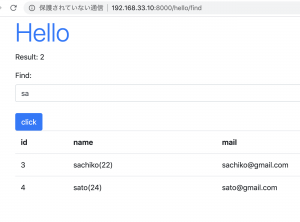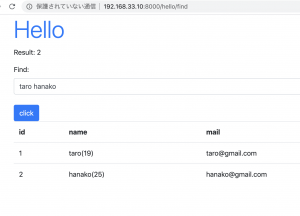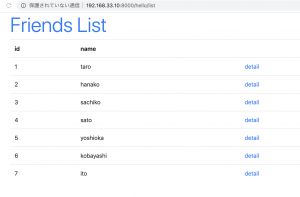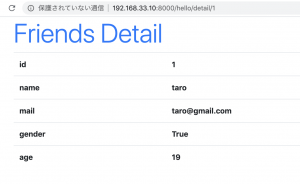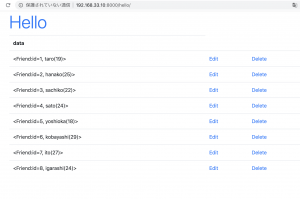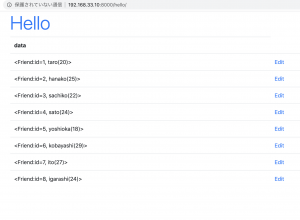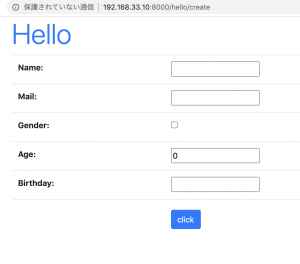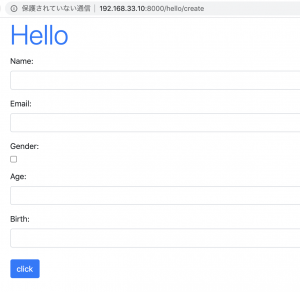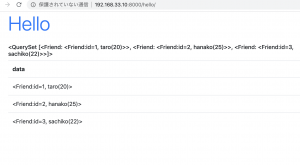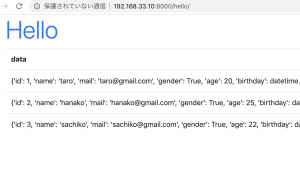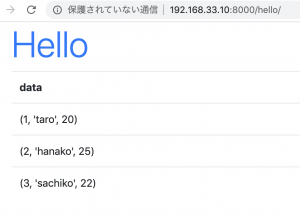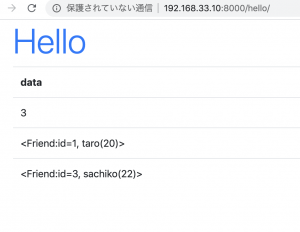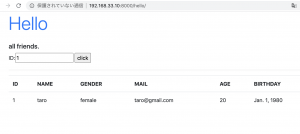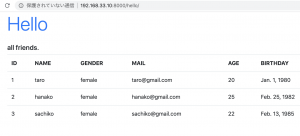Managerクラスの「order_by」メソッドで行う
/hello/views.py
def index(request):
data = Friend.objects.all().order_by('age')
params = {
'title': 'Hello',
'message': '',
'data': data,
}
return render(request, 'hello/index.html', params)
/hello/templates/hello/index.html
<body class="container">
<h1 class="display-4 text-primary">{{title}}</h1>
<p>{{message|safe}}</p>
<table class="table">
<tr>
<th>id</th>
<th>name</th>
<th>age</th>
<th>mail</th>
<th>birth</th>
</tr>
{% for item in data %}
<tr>
<td>{{item.id}}</td>
<td>{{item.name}}</td>
<td>{{item.age}}</td>
<td>{{item.mail}}</td>
<td>{{item.birthday}}</td>
</tr>
{% endfor %}
</table>
</body>
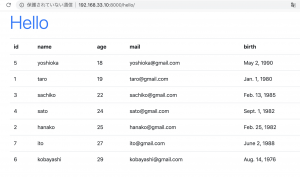
逆の場合はorder_by().reverse()とする
data = Friend.objects.all().order_by('age').reverse()
### 指定した範囲のレコードを取り出す
/hello/views.py
def find(request):
if(request.method == 'POST'):
msg = 'Search Result:'
form = FindForm(request.POST)
find = request.POST['find']
list = find.split()
data = Friend.objects.all()[int(list[0]):int(list[1])]
else:
msg = 'search words...'
form = FindForm()
data =Friend.objects.all()
params = {
'title': 'Hello',
'message': msg,
'form': form,
'data': data,
}
return render(request, 'hello/find.html', params)
/hello/templates/hello/find.html
<body class="container">
<h1 class="display-4 text-primary">{{title}}</h1>
<p>{{message|safe}}</p>
<form action="{% url 'find' %}" method="post">
{% csrf_token %}
{{ form.as_p }}
<tr>
<th></th><td><input type="submit" value="click" class="btn btn-primary mt-2"></td>
</tr>
</form>
<table class="table">
<tr>
<th>id</th>
<th>name</th>
<th>age</th>
<th>mail</th>
<th>birthday</th>
</tr>
{% for item in data %}
<tr>
<td>{{item.id}}</td>
<td>{{item.name}}</td>
<td>{{item.age}}</td>
<td>{{item.mail}}</td>
<td>{{item.birthday}}</td>
</tr>
{% endfor %}
</table>
</body>
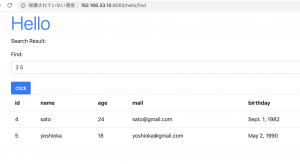
### レコードの集計
aggregateメソッドで集計を行わせる
– count: レコード数
– sum: 合計
– avg: 平均
– min: 最小値
– max: 最大値
/hello/views.py
from django.db.models import Count, Sum, Avg, Min, Max
def index(request):
data = Friend.objects.all()
re1 = Friend.objects.aggregate(Count('age'))
re2 = Friend.objects.aggregate(Sum('age'))
re3 = Friend.objects.aggregate(Avg('age'))
re4 = Friend.objects.aggregate(Min('age'))
re5 = Friend.objects.aggregate(Max('age'))
msg = 'count:' + str(re1['age__count']) + '<br>Sum:' + str(re2['age__sum']) + '<br>Average:' + str(re3['age__avg']) + '<br>Min:' + str(re4['age__min']) + '<br>Max:' + str(re5['age__max'])
params = {
'title': 'Hello',
'message': '',
'data': data,
}
return render(request, 'hello/index.html', params)
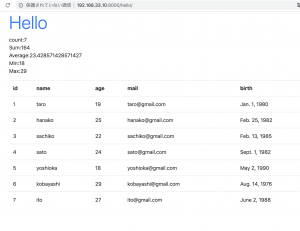
avgの小数点以下がおかしなことになってますが、filterを使えば大抵の事は出来るとのこと。


